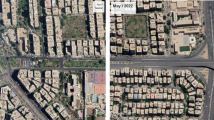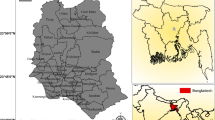Abstract
This research was conducted to assess the performance of horizontal shading device on the building shadow area in two different climates of Iran. The case studies were two holy shrines in Shiraz and Savadkouh (semi arid climate and humid and moderate climate respectively) and were prioritized by Analytical Hierarchy Process weights. The solar angles and shadow area were derived and compared accordingly. The results showed that the shadow on the beneath wall of the lower latitude case study (Shiraz: 29°33′N) was 48.21% in January and 100% in July, and the parallel ratio for Savadkouh was 26.1% in January and 97.22% in July. Through comparison of the monthly shadow area on wall in July with that in January in both climates, the Shiraz and Savadkouh ratios were found to be 2.78 and 4.79, respectively, which indicated that shadow areas in summer were more than those in winter. Therefore, the shadow could cause more outdoor thermal comfort in winter and summer in both climates.
Similar content being viewed by others
References
Ahrens, C. D. (2007). Meteorology today: An introduction to weather, climate, and the environment, Thomson Higher Education, Belmont.
Bessoudo, M., Tzempelikos, A., Athienitis, A. K., and Zmeureanu, R. (2010). “Indoor thermal environmental conditions near glazed facades with shading devices — Part I: Experiments and building thermal model.” Building and Environment, Vol. 45, No. 11, pp. 2506–2516, DOI: http://dx.doi.org/10.1016/j.buildenv.2010.05.013.
Casals, X. G. (2006). “Analysis of building energy regulation and certification in Europe: Their role.” Limitations and Differences, Energy Build, Vol. 38, No. 5, pp. 381–92.
Chel, A. and Tiwari, G. N. (2009). “Thermal performance and embodied energy analysis of a passive house-case study of vault roof mudhouse in India.” Applied Energy, Vol. 86, No. 10, pp. 1956–1969, DOI: http://dx.doi.org/10.1016/j.apenergy.2008.12.033.
Chinese, D., Nardin, G., and Saro, O. (2011). “Multi-criteria analysis for the selection of space heating systems in an industrial building.” Energy, Vol. 36, No. 1, DOI: http://dx.doi.org/10.1016/j.energy.2010.10.005.
Cooper, P. I. (1969). “The absorption of radiation in solar stills.” Solar Energy, Vol. 12, No. 3, DOI: http://dx.doi.org/10.1016/0038-092X(69)90047-4.
Dimoudi, A. and Tompa, C. (2008). “Energy and environmental indicators related to construction of office buildings.” Resour. Conserv. Recycl., Vol. 53, No. 1, pp. 86–95.
Duffie, J. A. and Beckman, W. A. (1991). Solar engineering of thermal processes (second ed.), John Wiley and Sons Inc, New York.
Ghobadian, V. (2004). Climate investigation of the Iran traditional buildings (third ed.), Tehran University Press, Tehran.
Goswami, D. Y., Kreith, F., and Kreider, J. F. (2000). Principles of solar engineering, 2nd ed., Taylor and Francis, Philadelphia.
Habib, F. and Barzegar, Z. (2014). “Evaluation of the horizontal shading device effect on building envelopes received solar radiation — A case with SE orientation in Shiraz.” Advances in Environmrntal Biology, Vol. 8, No. 4, pp. 1123–1132.
Ho, W. (2008). “Integrated analytic hierarchy process and its applications — A literature review.” European Journal of Operational Research, Vol. 186, No. 1, pp. 211–228, DOI: http://dx.doi.org/10.1016/j.ejor.2007.01.004.
Hwang, R.-L., Lin, T.-P., and Matzarakis, A. (2011). “Seasonal effects of urban street shading on long-term outdoor thermal comfort.” Building and Environment, Vol. 46, No. 4, DOI: http://dx.doi.org/10.1016/j.buildenv.2010.10.017.
Iran Institute for International Energy Studies (IIES). (2010). Hydrocarbon balance 2008, Iran Ministry of Power (2010), Tehran.
Jaber, J. O., Jaber, Q. M., Sawalha, S. A., and Mohsen, M. S. (2008). “Evaluation of conventional and renewable energy sources for space heating in the household sector.” Renewable and Sustainable Energy Reviews, Vol. 12, No. 1, pp. 278–289, DOI: http://dx.doi.org/10.1016/j.rser.2006.05.004.
Nicol, J. F. and Humphreys, M. A. (2002). “Adaptive thermal comfort and sustainable thermal standards for buildings.” Energy and Buildings, Vol. 34, No. 6, pp. 563–572, DOI: http://dx.doi.org/10.1016/S0378-7788(02)00006-3.
Oliver, J. E. (2005). Encyclopedia of world climatology (encyclopedia of earth sciences Series) (fifth ed.), Dordrecht.
Pfeiffer, A., Koschenz, M., and Wokaun, A. (2005). “Energy and building technology for the 2000 W society-Potential of residential buildings in Switzerland.” Energy and Buildings, Vol. 37, No. 11, pp. 1158–1174, DOI: http://dx.doi.org/10.1016/j.enbuild.2005.06.018.
Pohekar, S. D. and Ramachandran, M. (2004). “Application of multicriteria decision making to sustainable energy planning a review.” Renewable and Sustainable Energy Reviews, Vol. 8, No. 4, pp. 365–381, DOI: http://dx.doi.org/10.1016/j.rser.2003.12.007.
Quaschning, V. (2005). Understanding renewable energy systems, Earthscan, London.
Rafee, Z. (2011). Nafar development process in vernacular architecture of Mazandaran, Bagh Nazar.
Reza, B., Sadiq, R., and Hewage, K. (2011). “Sustainability assessment of flooring systems in the city of Tehran: An AHP-based life cycle analysis.” Construction and Building Materials, Vol. 25, No. 4, pp. 2053–2066, DOI: http://dx.doi.org/10.1016/j.conbuildmat.2010.11.041.
Saaty, T. L. (1980). The analytic hierarchy process, McGraw-Hill, New York.
Saaty, T. L. (2001). Fundamentals of decision making and priority theory with the analytic hierarchy process, RWS Publications, Pittsburgh.
Soflae, F. (2005). Division lines between climates, the environmental effect of central courtyard on the sustainable residential buildings in arid climate of Iran, PhD Thesis, Science and research Branch, Islamic Azad University, Tehran.
Technical and Engineering Department of Shahecheragh Shrine (2011). Shrine plan and elevations, Shiraz
The Iran Geographical and Cartography Longitude Organization. (1995). Iran face, tourism and travel guide, Tehran.
Wong, J. and Li, H. (2008). “Application of the Analytic Hierarchy Process (AHP) in multi-criteria analysis of the selection of intelligent building systems.” Building and Environment, Vol. 43, No. 1, pp. 108–125, DOI: http://dx.doi.org/10.1016/j.buildenv.2006.11.019.
Yang, Y., Li, B., and Yao R. (2010). “A method of identifying and weighting indicators of energy efficiency assessment in Chinese residential buildings.” Energy Policy, Vol. 38, No. 2, pp. 7687–7697, DOI: http://dx.doi.org/10.1016/j.enpol.2010.08.018.
Zheng, G., Jing, Y., Huang, H., Shi, G., and Zhang, X. (2010). “Developing a fuzzy analytic hierarchical process model for building energy conservation assessment.” Renewable Energy, Vol. 35, No. 1, pp. 78–87, DOI: http://dx.doi.org/10.1016/j.renene.2009.07.008.
Author information
Authors and Affiliations
Corresponding author
Rights and permissions
About this article
Cite this article
Habib, F., Barzegar, Z. & Cheshmehghasabani, M. Adjustment comparison of veranda effect on building shadow area in semi-arid and moderate climates. KSCE J Civ Eng 19, 1256–1264 (2015). https://doi.org/10.1007/s12205-015-0021-0
Received:
Revised:
Accepted:
Published:
Issue Date:
DOI: https://doi.org/10.1007/s12205-015-0021-0




